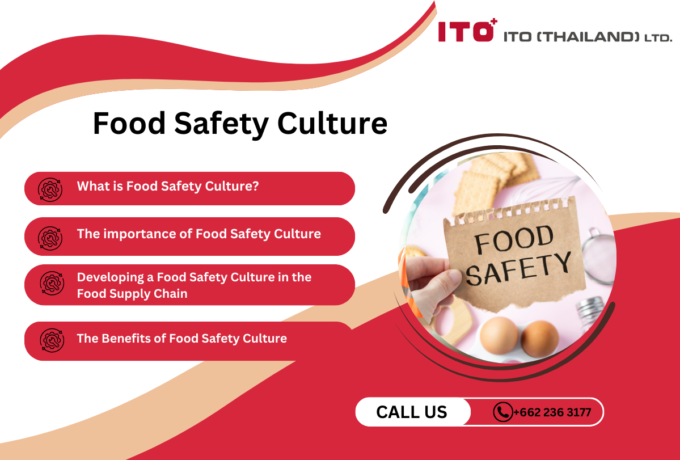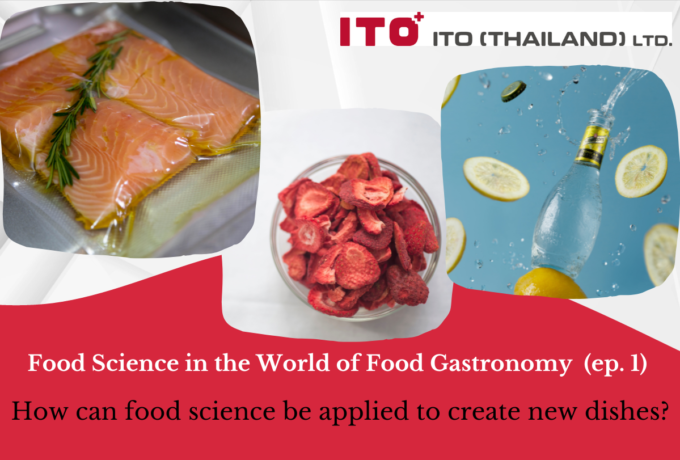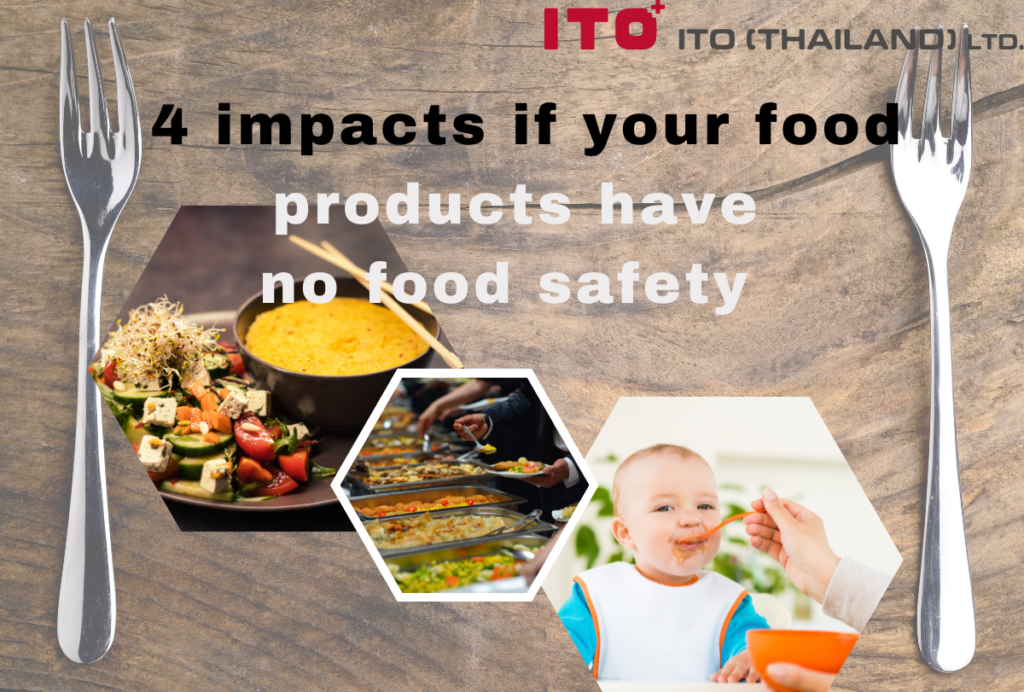ITO Thailand Hygiene Blog
4 impacts if your food products have no food safety (Part 1)
4 impacts if your food products have no food safety (Part 1)
1.Health Risks
Consumers who have taken unsafe food may have obtained various impacts on their health as follows:
Physical hazards
The most commonly found physical hazards in food are usually solid or sharp adulterated things that destroy the digestive tract (Read more: Physical hazards, prevention and monitoring) and are the common and acute hazards such as the news of eating food contaminated with a piece of steel wool that seriously resulted to emergency surgery [1], a fishbone stuck in the throat that can be deeply implanted or infected [2] or a tooth broken due to chewing a gravel adulterated in rice [3], etc.
Chemical hazards
Chemical hazards contaminated in food may be caused by contamination in raw materials such as animal hormones, pesticides, heavy metals in water, adding food additives, over adding additives or preservatives or wrong mixing causing some food to contain chemicals exceeding the safety level, adding banned substances or harmful substances to improve quality such as bleach, formaldehyde, chemicals produced by the production processes such as carcinogens of Acrylamide group caused by Mellard reaction in food that is heated until become browning or the formation of trans fats in cooking oil that has been repeatedly fried at high temperatures, etc. including other chemicals that are used in food production areas and may be at risk of contamination into food such as cleaning agents, lubricants, disinfectants, pesticides (rats, insects), fuels, etc. Read more.
Physical symptoms arising from the consumption of chemically harmful food may be either acute symptom if getting a lot of toxins at once, such as pain or dizziness, nausea, abdominal pain, vomiting, blurred vision, fatigue, stomach upset, etc., or if getting too much toxins, it can cause internal organ failure or death, or toxins may be accumulated causing harm in a long-term, such as cancer, Minamita disease caused by mercury, Itai-itai disease caused by cadmium. Also, the case of antimicrobial resistance due to eating meat contaminated with antibiotics, etc.
Presently, the news of chemical contamination in food has still been regularly reported such as cadmium-contaminated dried squid [4], pesticide residues in oranges [5], triazophos residues in frozen red chili exceeding the standard resulting Japan to raise the random inspections of chemicals from the products imported from Thailand by 30% increase [6], including the case of carcinogens (2-Chloroethanol) found in ice cream led to product recalls in many countries [7].
Biological hazards
Biological hazards can be caused by microorganisms or microbial toxins usually found in the products of which production processes are not complied with good food production practices, such as raw materials overly contaminated with microorganisms, inefficient or error in microbial reduction processes e.g., washing and cleaning, heating, water activity reduction, increasing the acidity, etc., microbial contamination e.g., cross contamination from raw materials to products, contamination by workers, contamination by other environments which may cause small consumer health effects e.g., diarrhea, abdominal discomfort up to severe symptom of getting shock and even death, including possibly causing an outbreak resulting to wide damage.
Problems of biological hazards are assumed to be ever experienced by everyone; for example, stomachache or stomach upset when eating unhygienically produced food, unclean or not fresh raw materials or exposed to various vectors. Such cases becoming big news are both at the national level; for example, a large number of people having diarrhea in Chanthaburi Province in December 2021 due to Norovirus contamination [8], and at international level about the closure of an infant formula factory in the United States in early 2022 due to Cronobacter contamination causing 4 infants became sick and 2 dead resulted to the severe infant formula shortage in the United States [9].
Allergen hazards
Allergen hazards are caused by some consumers being sensitive to certain proteins found in food. Sometimes they can also be considered as chemical hazards. The difference between chemical hazard and allergen hazard is chemical hazard is dangerous for everyone while allergen hazard is dangerous only for people who are allergic to that substance only. Details about the dangers of this group of substances can be further read under the topic: Allergens.
2.Loss of reputation and confidence in the organization
When consumers are in danger of food contamination or have encountered noticeable contaminations (e.g., contaminated with hair, insects and foreign matters, etc.), the food manufacturer must be liable for any damage occurred. Also, there is a possibility for the consumers to make complaints or tell what they have found on various online platforms via social media making the story spread quickly. In an event that the danger is widespread or seriously dangerous, the spread of the news will become viral affecting the confidence in the organization in the long run.
Besides, detection of contamination that does not meet export standards may result in the destination country losing confidence in the products exported from Thailand causing the product inspection to become increasingly strict or prohibition of the import of products from that particular country; for example, the case of increasing the level of chemical inspection in red chili exported from Thailand to Japan [6] and the United Kingdom [10] due to chemical contamination was found over the standard.
–To be continued–
References
1.https://www.thairath.co.th/news/society/2514190
2.https://mgronline.com/onlinesection/detail/9650000094633
3.https://d.dailynews.co.th/regional/753719/
4.https://consumerthai.org/consumers-news/consumers-news/food-and-drug/4498-633107-html
5.https://consumerthai.org/consumers-news/food-and-drug.html
6.https://www.doa.go.th/psco/?p=7656
7.https://www.thansettakij.com/world/536141
8.https://www.thaipbs.or.th/news/content/311212
Related Post
-

Food Safety Culture
Food safety culture plays a crucial role in safeguarding the company's reputation, ensuring the well-being of its employees, and providing a safe experience for its customers.
-

New food source safety issues
What are safety issues worth knowing for trendy new food sources like plant-based and insect-based proteins?
-

British Retail Consortium (BRC) Standard
Food safety management systems play a vital role in ensuring the production and distribution of safe and high-quality food products to consumers. With the global food supply chain becoming increasingly complex, food businesses must implement effective systems prioritising safety, quality, and compliance with industry standards. A food safety management system encompasses a set of procedures, processes, and controls designed to identify, prevent, and manage potential hazards at every stage of the food production and supply process. This proactive approach not only safeguards consumers' health but also protects the reputation and credibility of food companies in an ever more competitive market.
-

Food Science in the World of Food Gastronomy (Part 1)
How can food science be applied to create new dishes?
-

FSSC 22000
Food manufacturers must ensure food safety standards and processes. FSSC 22000 is an official certification program for Food Safety Management Systems (FSMS) recognised by the Global Food Safety Initiative (GFSI). This certification scheme offers a set of guidelines and procedures to ensure uniformity, openness, and safety across your entire supply chain. It applies to all companies operating within the food and beverage industry, ranging from farmers to retailers. By fulfilling the necessary criteria and obtaining FSSC 22000 certification, it is demonstrated that the required standards for food quality and implementing effective processes to manage and mitigate risks associated with food fraud, foodborne illnesses, expensive recalls, and other external threats are met.
-

Food Safety Aspects of Artificial Sweeteners
Artificial sweeteners, also known as sugar substitutes, non-nutritive sweeteners, or high-intensity sweeteners, are artificially produced compounds utilised in place of sucrose (table sugar) to add sweetness to food and drinks. Due to their significantly higher sweetness than regular sugar, only a fraction of artificial sweeteners (200 to 20,000 times less) is required to achieve an equivalent level of sweetness. Since the caloric contribution of these sweeteners, when used in such small quantities, is insignificant, they are often referred to as non-nutritive (4).










